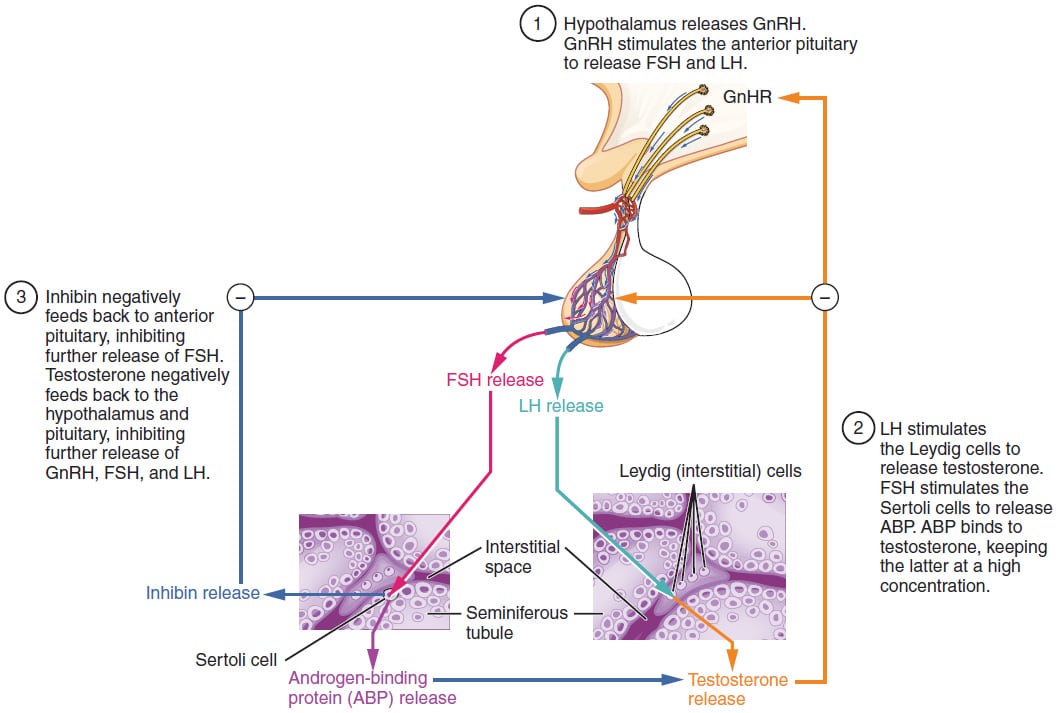Menopause is the permanent cessation of menstruation resulting from the loss of ovarian function. Throughout reproductive life the number of follicles decreases. This process accelerates in the late thirties. Inhibin levels produced by the granulosa cells gradually reduce leading to rise in FSH. Raised FSH leads to increased estradiol production by the ovaries for a few years preceding actual menopause, which can cause menstrual irregularities. More cycles become anovulatory. Mean follicular phase and menstrual cycle length may be reduced before menopause. At first, the luteal phase is of normal duration, but luteal dysfunction eventually may occur because of a fall in progesterone levels. Finally, estradiol and inhibin levels decline while FSH and LH remain elevated. Gonadotropin levels greater than 30 mIU/ml are typically diagnostic of menopause, with the ratio of FSH to LH being greater than 1.
The estrogen produced after menopause is primarily from the peripheral conversion of adrenal androgens and occurs in the liver, kidney, brain, adrenal, and peripheral adipose tissue. Estradiol is present in low levels too, from peripheral conversion of estrone. Obese women have a higher concentration of free estradiol because of decreased sex hormone-binding globulin and an increased rate of aromatization.
Menopause is associated with vasomotor disturbances characterized by hot flashes, genital atrophy and psychologic symptoms. The decline in estrogen also causes an increased risk of osteoporosis. Vasomotor instability appears to arise not from a lack of estrogen but rather from its withdrawal. Flashes appear to be more severe at times of stress and more frequent and severe at night, when they are called night sweats. Hot flashes are accompanied by pulses of LH and increase in the levels of ACTH, cortisol, dehydroepiandrosterone and androstenedione.
| Unavoidable Risk Factors | Avoidable Risk Factors | Protective Factors |
| Genetic predisposition | Lack of physical exercise | Obesity |
| Low bone mass | Insufficient calcium intake | Multiparity |
| Slender build | Smoking | Muscular habitus |
| White or Asian race | Excessive alcohol intake | Black race |
| Premature ovarian failure | Excessive caffeine intake | Prolonged oral contraceptive use |
| Surgical menopause | Estrogen deficiency | Hormone replacement therapy |
| Glucocorticoid therapy | Anorexia nervosa | |
| Nulliparity | Excessive exercise | |
| Excessive thyroid replacement |
Testosterone is secreted by the Leydig cells of the testes. The testicular enzyme 17 beta hydroxysteroid dehydrogenase converts androstenedione to testosterone. The enzyme 5 alpha reductase converts testosterone to dihydrotestosterone or DHT. Testosterone circulates in the plasma bound to sex hormone binding globulin and albumin. Only free hormone is biologically active. Pulsatile release of GnRH stimulates the release of FSH and LH from the anterior pituitary. FSH stimulates spermatogenesis and Sertoli cell function. LH stimulates Leydig cells to synthesize testosterone. Testosterone has both paracrine and endocrine effects. It supports Leydig cell function and promotes spermatogenesis. Testosterone exerts negative feedback on both the hypothalamus and anterior pituitary to inhibit the secretion of GnRH and LH respectively. Sertoli cells secrete inhibin which inhibits FSH secretion from the anterior pituitary. Sertoli cells also secrete AMH or anti-mullerian hormone which causes atrophy of the mullerian ducts.

Sign up for free to take 7 quiz questions on this topic